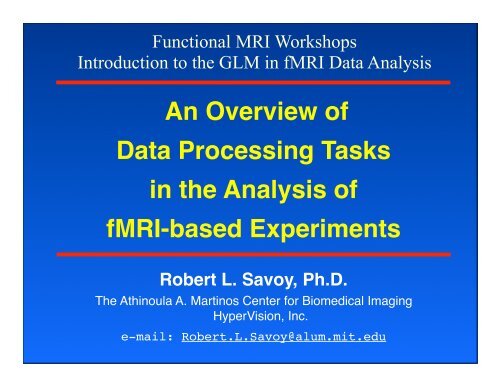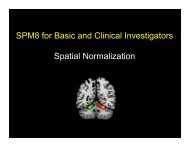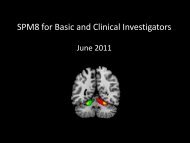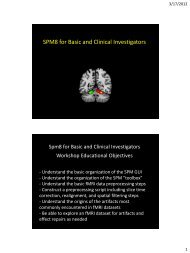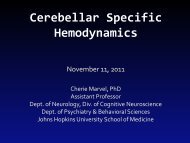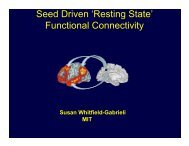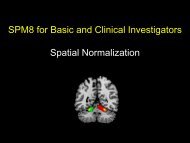fMRI signal + - Neurometrika
fMRI signal + - Neurometrika
fMRI signal + - Neurometrika
- No tags were found...
You also want an ePaper? Increase the reach of your titles
YUMPU automatically turns print PDFs into web optimized ePapers that Google loves.
NMRData AnalysisPracticalitiesMRIPsychophysiologicalLaboratoryExperimentalTaskHemodynamicsFunctionalNeuroanatomyExperimental DataAnalysis DesignComparingBrainsComputationalNeuroanatomy
Overview of SPMImagetime-seriesSpatialSmoothingKernelDesignmatrixStatistical parametric map(SPM)RealignmentSmoothingGLM: GeneralLinear Model“SpatialNormalisation”StatisticalinferenceGaussianfield theoryStandardizedAnatomicalTemplateParameterestimatesp
Overview of SPMImagetime-seriesSpatialSmoothingKernelDesignmatrixStatistical parametric map(SPM)Realignment“SpatialNormalisation”SmoothingGLM: GeneralLinear ModelPreprocessing Modeling InferenceStatisticalinferenceGaussianfield theoryStandardizedAnatomicalTemplateParameterestimatesp
Lecture 1Optimizing Data AcquisitionThis is the attempt to get the best quality images that you canfrom your scanner, subject, and experiment.
Lecture 2Preprocessing: RealignmentPrimarily, this is to compensate, on a global level, for the factthat living subjects move. It is “realigning” images withsimilarly collected images---images like themselves.
Lecture 2Preprocessing: Spatial SmoothingThis is almost always done, because the size of the activatedregion is typically larger than a single voxel. It benefits thestatistical analysis in a number of ways...in most experiments.
Lecture 2Preprocessing: Spatial NormalizationPutting brain data in a “standard” 3-dimensional coordinatespace permits group analysis and reporting findings.Realignment can be associated with “spatial normalization whengoing between imaging modalities (PET & <strong>fMRI</strong>; T1 & T2*)
Lecture 3Modeling for First Level EstimationThis is the search for “task-related activity”in each individual subject.
Overview of SPMImagetime-seriesSpatialSmoothingKernelDesignmatrixStatistical parametric map(SPM)Realignment“SpatialNormalisation”SmoothingGLM: GeneralLinear ModelPreprocessing Modeling InferenceStatisticalinferenceGaussianfield theoryStandardizedAnatomicalTemplateParameterestimatesp
effects of interesterror varianceeffects of no interestThe Jewelwe seek!ExplainedVarianceThe UnexplainedVariance,called “noise”effects of intereststatistic = -----------------------------error variance
Lecture 4Modeling for Second Level EstimationExperimentalDesign“Second Level” modeling can refer to many things.Most commonly, it refers to group analyses of various kinds.
Lecture 5Inference and Critical ThresholdsNo StatisticsHere!Inference and “critical thresholds” are a core part of the historyof the SPM software package. “Gaussian Random Field” theorywas an attempt to deal with the problem of multiple comparisonswithout invoking the overly stringent Bonferonni correction.
View 1:A series of volumes(scans, 3D “images”)Useful for seeking spatio-temporalpatterns, e.g., via PCA, ICA, etc.View 2:Multiple voxel time seriesUseful for seeking temporalpatterns in each individualvoxel of the volumes.Two Views on <strong>fMRI</strong> DataStandard hypothesis-driven statisticalanalysis (e.g., GLM) goes withview 2 since it is appliedindependently for each voxel timecourse, i.e.,“voxel-wise” statistical analysis.
Inference: Use Uncertainty of Parameter Estimatesa)b)noise noisenoisenoiseMean 2Mean 1RestStimRestStim• Same mean values in Rest and Stim condition in cases a) and b)Simple subtraction (difference = Mean 2 – Mean 1) yields same result !Simple subtraction does NOT consider variance of means (noise)• Statistical analysis (e.g., t test) relates estimate (mean difference) touncertainty of estimate = pooled variance of values within conditions, i.e.
From Experimental Timing to Expected <strong>fMRI</strong> Time CourseNeural pathway Hemodynamics MR scannerConvolution kernel
The General Linear Model (GLM)β 0×X 0<strong>fMRI</strong> <strong>signal</strong>= β 1×X 1+++residualsTimeβ 2×X 2Timedesign matrixTimeThe design matrix models expected <strong>signal</strong> time courses for individual conditions (effects of interest), butmay also include additional predictor time courses (confounds, effects of no interest) helping to improveexplaining the data. In this example, two main predictors are defined (X 1and X 2). A “constant” predictor(X 0) is required to fit the base level of the <strong>signal</strong> time course. The expected time courses are obtained byconvolving the condition “box-car” functions (red / green) with the assumed impulse response (HRF, twogammafunction).
The General Linear Model (GLM)β 0×X 0<strong>fMRI</strong> <strong>signal</strong>= β 1×X 1+++residualsTimeβ 2×X 2Timedesign matrixTime...The expected time courses are obtained byconvolving the condition “box-car” functions(red / green) with the assumed impulseresponse (HRF, two-gamma function).
The General Linear Model (GLM)Time= β 0× + β 1× + β 2× +Time<strong>fMRI</strong> <strong>signal</strong>design matrixresidualsThe time courses of the <strong>signal</strong>, predictors and residuals can be rearranged in column form with timerunning from top to bottom. This view is helpful to understand the matrix form of the General LinearModel.
The General Linear Model (GLM)estimate!β 0× β 1×β 2×Time= + ++<strong>fMRI</strong> <strong>signal</strong>= datadesign matrix= model(defined by YOU)residuals= error
The General Linear Model (GLM)estimate!β 0× β 1×β 2×Time= + ++<strong>fMRI</strong> <strong>signal</strong>= datadesign matrix= model(defined by YOU)residuals= errorThe GLM time courses, especially the design matrix is often shown in a graphical view using a black-towhitecolour range for coding (expected) <strong>signal</strong> intensities.
Time= + + +<strong>fMRI</strong> <strong>signal</strong>= datadesign matrix= model(defined by YOU)residuals= errorTime=+++<strong>fMRI</strong> <strong>signal</strong>= datadesign matrix= model(defined by YOU)residuals= error
With many thanks for slides& images to:FIL Methods group
⊗
Convolve stimulusfunction with a canonicalhemodynamic responsefunction (HRF):⊗Stimulus timing shown in REDStimulus timing convolved with the “canonical” HRF Shown in GREENMR data shown in BLUE
Stimulus timing convolved with the“canonical” HRF...What is the use, in most analyses, of “canonicalHRF” function?It refers to the fact that the SAME “HRF” is usedFOR ALL voxels in the brain,FOR ALL stimulus types,FOR ALL subjects!
Stimulus timing convolved with the“canonical” HRF...One can use the “Finite Impulse Response (FIR)”model to estimate the HRF individually: for eachvoxel in the brain, for each stimulus type, for eachsubject.In practice, full FIR analysis is rarely done. Butestimating the dispersion and delay of the HRFindividually on a voxel basis, and then treating thoseas “covariates of no interest”, is more commonlyuseful.
The General Linear Model (GLM)
The GLM in Matrix Notationobserved variable,<strong>fMRI</strong> time coursedesignmatrixbeta weights,coefficientserrors,residualspredictor,explanatory variable,regressor, covariate,basis functionanother predictor...one of “k” functions tohelp fit the data in theGLM
The GLM in Matrix Notation
The GLM in Matrix NotationObserved <strong>fMRI</strong> <strong>signal</strong>:Predicted <strong>fMRI</strong> <strong>signal</strong>:Prediction error:
Fitting a GLM
Observed <strong>fMRI</strong> <strong>signal</strong>Predicted <strong>fMRI</strong> <strong>signal</strong>residualsb 0 = 101.9design matrixGLM – Example, block design
Observed <strong>fMRI</strong> <strong>signal</strong>Predicted <strong>fMRI</strong> <strong>signal</strong>residualsb 0= 101.6+b 1= 1.8design matrixGLM - Example
Observed <strong>fMRI</strong> <strong>signal</strong>Predicted <strong>fMRI</strong> <strong>signal</strong>residualsb 0= 101.0+b 1= 4.5design matrixGLM - Example
Observed <strong>fMRI</strong> <strong>signal</strong>Predicted <strong>fMRI</strong> <strong>signal</strong>residualsb 0= 100.2+b 1= 3.4+b 2= 5.5GLM - Exampledesign matrix
Lessons from the GLM Example• To obtain optimal GLM fits, all known effects should be modelled inthe design matrix.• Non-modelled effects are moved to the residuals, substantiallyincreasing the error variance. This leads to poor fits and reducedstatistical power (the error variance is one component of the standarderror of contrasts).• Inspection of the residuals is a good diagnostic to assess thegoodness-of-fit of a GLM: If one observes prominent, low-frequencyfluctuations, it is likely that not all effects have been modelled or thatthe modelled time courses do not fit to the data. The latter might befor example, due to delayed <strong>fMRI</strong> responses with respect to predictors.• Confound predictors may be added to improve the fit, for example,predictors capturing low-frequency drifts (Fourier basis functions orDiscrete Cosine Transform, DCT, basis functions), if drifts are notremoved already during data preprocessing.
Functional MRI WorkshopsIntroduction to the GLM in <strong>fMRI</strong> Data AnalysisAn Overview ofData Processing Tasksin the Analysis of<strong>fMRI</strong>-based ExperimentsRobert L. Savoy, Ph.D.The Athinoula A. Martinos Center for Biomedical ImagingHyperVision, Inc.e-mail: Robert.L.Savoy@alum.mit.edu


